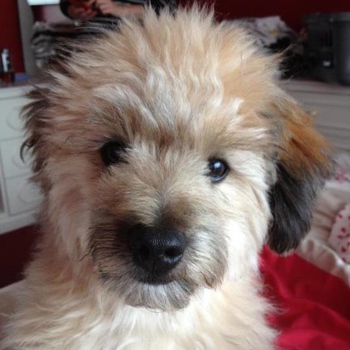Pomapoo

Cuddly little teddy bears, Pomapoos are a hybrid mix of the Pomeranian and the Poodle whose popularity has taken off around the world thanks to their undeniable cuteness and sweet temperaments. The demand for small designer dogs is ever increasing because of the growing number of families living in apartments in urban areas.
Pomapoos have an elegant gait and delicate body, covered in soft, wavy fur that can be a number of different colours, including cream, red and brown. Dogs that love to be close to people, Pomapoos form very strong attachments to their owners and will rarely allow them to leave a room without following them!
About & History
Pomapoos are also known as Pomeroodles and Pooranian and were probably first developed in the 1980s or 1990s. Wonderful family pets, they have never been used to work but instead are kept as companions. We can learn more about them by taking a closer look at the history of each parent breed used in their creation.
The Pomeranian
Pomeranians are the smallest Spitz type dogs that exhibit the classic plush fur, prick ears, pointed snout and curled over tail that gives them that much-loved ‘foxy’ appearance. Though they may be much smaller, they are in fact closely related to breeds, such as the Samoyed and the Keeshond. Pomeranians were initially bred in a historical place called ‘Pomerania’ bordering the Baltic Sea, sometime around the 18th century.
A dog with a truly noble background, it was Queen Victoria of England that took a shine to them during her reign. Many experts believe it was thanks to Queen Victoria’s efforts alone that the breed shrunk to about 50% of its original size, owing to her desire for ever smaller Pomeranians. They are currently classified within the Kennel Club’s Utility Group and are regularly used as therapy pets because of their intelligence and docile natures.
The Poodle
Poodles are a curly-coated breed that originate from Germany, not too far from where the Pomeranian was established. The three variants of Poodle (Miniature, Toy and Standard) offer breeders and owners the choice of having a small, medium or larger-sized pet. This feature has ensured their popularity with the hybrid dog market, where they feature heavily.
Poodles are known to be water dogs and would traditionally be used to hunt both on land and in water. While they are not often seen as hunting dogs nowadays (mainly due to their fur type that can be high maintenance when working outdoors), they continue to contribute to society by working as therapy dogs and are commonly seen in canine competitions and shows.
Appearance

Small dogs that typically measure from 20cm to 25cm and weigh between 3kg and 7kg, Pomapoos are larger than their Pomeranian relatives but are still undoubtedly ‘pocket-sized’. They are generally sturdier and more robust than Pomeranians but maintain a fine bone structure and a sophisticated conformation. Indeed, many people see this as a positive thing, as Pomapoos are more resilient to rough and tumble play.
Pomapoos have relatively small, cute faces and exhibit a variety of ear types. Some maintain the erect Spitz-type ears of the Pomeranian, while others may have semi-erect or even completely pendulous ears. Their eyes are round and dark, with a merry and inquisitive expression. Their short legs support a compact, neat body that ends in a tail that may hang straight out or curl along their back.
The beautiful coat of the Pomapoo is one of their most desirable features, usually consisting of wavy or crimped fur that is medium in length and soft to the touch. Some will have slightly thicker fur on their ears and tail. Solid coat colours, such as cream and brown, are common, though dogs can also have two tone coats and patches of different coloured fur.
Character & Temperament
A dog that relies on human companionship for their happiness, this is not a breed to be kept outdoors. They relish spending time with their family, often wanting to sit as close as possible to them (which may well mean taking up residence on their lap!). This friendliness might extend to other people but it is also possible for the Pomapoo to be guarded around strangers and it can take them some time to warm up to new arrivals. Owners can increase their acceptance of other people and animals by exposing them to a large number when they are maturing, during their vital socialisation period.
Wily and intelligent, not much gets past the Pomapoo and one doesn’t have to spend a long time in their company to realise that they are smarter than the average canine. They are always acutely aware of their surroundings and on the lookout for anything out of the ordinary. This trait makes them quite good watch dogs, but they are too small and affable to ever be trained as guard dogs.
Most owners will agree that the Pomapoo makes a delightful friend to young children and is tolerant of their shouting and unpredictability. It would be rare for a Pomapoo to be innately aggressive, but owners must be responsible and ensure that children are taught how to respect dogs and are never left unsupervised in their company. Even the most placid dog can be pushed to snap if a child constantly ignores its body language and warnings when it is uncomfortable or unhappy with a situation.
Trainability

Training a Pomapoo should be a pleasure, as they pick up on new tasks quickly and enjoy being given the opportunity to learn. They like to please their masters and respond well to positive reinforcement training, which uses vocal praise and treats to encourage good behaviour.
These smart cookies enjoy training sessions that are kept upbeat and varied, as they can become bored if constantly asked to repeat the same tasks.
Health
Being aware of the potential health problems a Pomapoo may encounter ensures that an owner will be on the lookout for them and will be able to pick up on them quicker, ensuring a better prognosis and quality of life. Below is a list featuring some of the conditions that Pomapoos are thought to be most susceptible:
Patellar Luxation
An orthopaedic condition affecting the knee, those with a luxating patella will find that it pops out of its usual position on occasion, leading to an abnormal gait and some degree of discomfort.
Most of the time, a vet can detect a patellar luxation by examining a dog and will then confirm the diagnosis and establish the severity of the issue by taking X-rays. If needed, there is a surgery available that can correct the issue. For those with a mild luxation, this may not be necessary and some dogs can be managed with lifestyle modifications alone.
Addison’s Disease
A relatively rare condition, Addison’s disease (or hypoadrenocorticism) is a hormonal disorder resulting from inadequate levels of cortisol and aldosterone. Symptoms can vary and may be vague, including episodes of stomach upset, lethargy and shaking.
Blood tests can confirm the diagnosis and lifelong medication can manage the symptoms. Those who are successfully stabilised should enjoy an excellent prognosis.
Collapsing Trachea
Small dogs in particular are prone to a trachea (windpipe) that collapses, which can cause a dry cough and a reduced ability to exercise and keep up with their peers. An x-ray can be used to determine the extent of the disease, though more advanced imaging methods, such as fluoroscopy are preferred.
In some instances, medications including cough suppressants and bronchodilators can control the signs, while more severe cases may benefit from surgery to widen the trachea with stents or meshes.
Exercise and Activity Levels
Well-suited to apartment life, the Pomapoo does not need a lot of space or a great deal of exercise. Most will keep themselves busy within the home, following after their owners and playing games. A couple of short walks around the block will keep them entertained and give them an opportunity to explore the outdoor world (and go to the toilet!).
Grooming
While coat type and length can vary somewhat from individual to individual, most will require brushing every day or two to minimise tangles and remove any debris that has become trapped.
Tear staining is a common cosmetic issue and can be controlled with daily cleaning. Those with floppy ears should have regular ear cleans to prevent wax build up. A professional groom every three to six months will keep Pomapoos looking their best.

